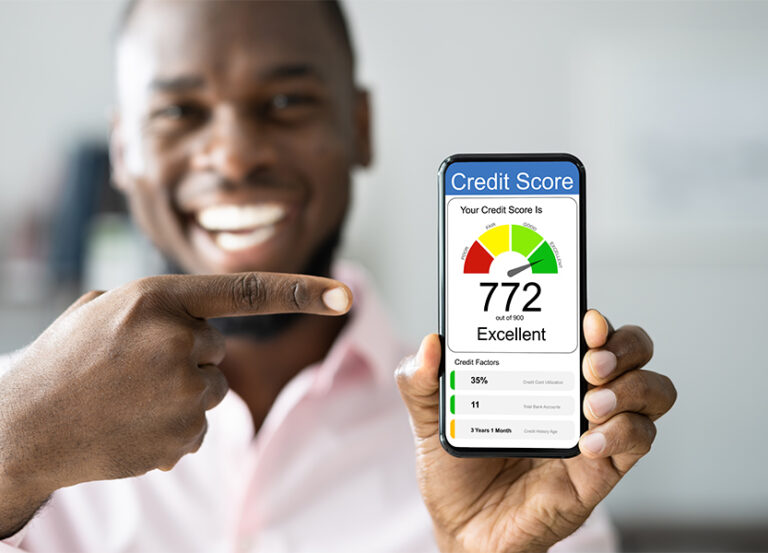How do I build a strong credit score?
Please rotate your device for the best experience.
Transcript
Building a Strong Score
Interactive Video
[A woman sitting on the floor leaning against a couch with her laptop in her lap and a dog beside her.]
Narrator: In sports, scores track what has already happened in a game.
[A scoreboard in a gymnasium, showing the home team has 32 points and the visiting team has 37 points.]
Credit scores use the past to help predict the future. They document your past financial actions on credit reports. Lenders and other decision-makers use those scores to predict if you will be responsible and make timely payments in the future.
[Animation: credit report shows a score of 722 and is used to predict whether or not this person will be responsible and make timely payments.]
Do you know your current credit score? If you don’t, finding out is the place to start.
[On screen text]: Do you know your credit score?
The three main credit reporting agencies—Experian, Equifax, and TransUnion—each allow a free credit report annually.
[On screen text]:
Main Credit Reporting Agencies
- Experian
- Equifax
- TransUnion
[A credit report from each agency appears. The Experian credit report has a credit score of 643. The Equifax credit report has a credit score of 649. The TransUnion credit report has a credit score of 651.]
There are also some free apps or websites that will let you monitor your credit score.
[A woman sitting on her bed looking at the tablet she is holding.]
You may wonder why your scores are different across the three credit agencies. Some use different analysis tools and calculations. They are complicated algorithms! The important thing to focus on is in what range your score falls. It should be relatively the same across the three agencies.
[A man with his arms crossed and a confused expression on his face. Three credit reports: The Experian credit report has a credit score of 643. The Equifax credit report has a credit score of 649. The TransUnion credit report has a credit score of 651.
[The algorithms and calculations are replaced with a credit score meter pointing to the Fair (580-669) range.]
Once you know your credit score, you can determine what actions you can take to help maintain or improve your score.
[A woman sitting on a couch beside an open laptop, writing in a notebook.]
[On screen text]: (A checklist with three items); credit score, maintain credit score, and improve credit score. “Credit score” has a check mark beside it.]
Credit agencies look at five key factors to calculate your score: on-time payment history at 35 percent, overall amount owed at 30 percent, number of years included in your credit history at 15 percent, new credit established at 10 percent, and a varied credit mix the final 10 percent.
[A donut chart titled “Credit Score Factors” , divided into 5 sections; varied credit mix 10%, new credit established 10%, on-time payment history 35%, credit history years 15%,overall amount owed 30%.]
You can play the credit game to win by following certain practices.
[A woman sitting on the floor leaning against a couch with her laptop in her lap and a dog beside her.]
[Credit Score Playbook: Select each card.]
Card 1
Positive Credit Types
- revolving credit
- credit cards
- installment loans
- personal loans
- mortgages
Narrator: First, adopt credit types that can help you and avoid those that raise flags. Revolving credit, such as credit cards, and installment loans, such as personal loans and mortgages, are positive credit types.
Card 2
Credit Types with Disadvantages
- payday loans
- high rates/short terms
- hard to pay off
- store credit cards
- high rates
- easy to overspend
- cosigning loans
- puts your credit at risk
- rent-to-own and lease-to-own agreements
- high upfront costs
- high rates
Narrator: You may want to sidestep credit types that come with some attached disadvantages. Payday loans have extremely high interest rates and short terms, which make it hard to pay them off. Store credit cards also have very high interest rates and make it way too convenient to overspend in your favorite stores. Cosigning loans for others puts your credit at risk if they don’t make their payments on time. Rent-to-own and lease-to-own agreements have high upfront costs and high interest rates.
Card 3
Positive Debt Practices
- Always pay on time.
- Keep debt balances low.
- Catch up on past-due payments.
- Pay down debt quickly.
- Only apply for credit you need.
- Limit how often you apply for new credit.
Narrator: Next, consistently practice managing your debt responsibly. Pay on time, every time. Keep your debt low; don’t get close to credit limits. Catch up on past-due payments, if you have any. Pay down debt as quickly as you can. Only apply for credit you need and limit how often you apply for new credit.
Card 4
Positive Credit Mix
- different credit types positively affects score
- demonstrates responsibility
[A pie chart with 5% segment for credit cards, 45% segment for mortgage, 20% segment for vehicle loan, and 30% segment for student loans.]
Narrator: Also, a dependable record with a mix of credit types positively affects your score. It shows a lender that you can handle different types responsibly.
Card 5
Report Accuracy
- Fact-check your credit reports.
- Look for errors or fraud.
[A credit report being examined by a magnifying glass. It has a score of 722 and lists two on-time payments and one late payment.]
Narrator: Finally, fact-check your credit reports to make sure there are no errors or fraudulent information.
